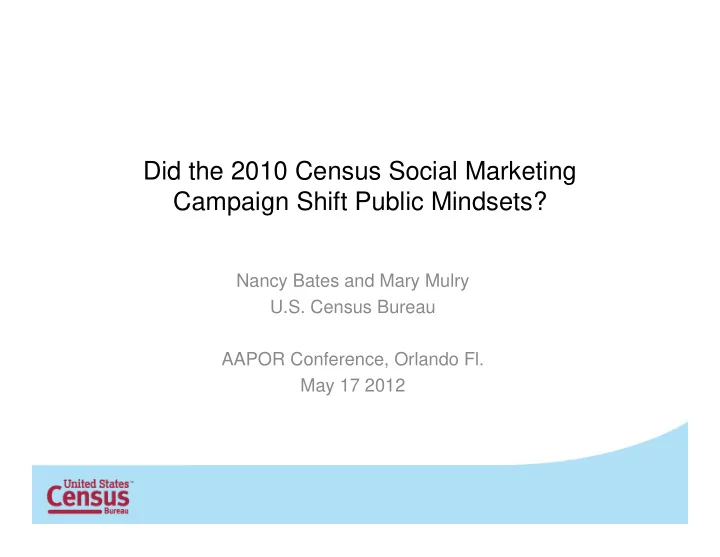

Did the 2010 Census Social Marketing Campaign Shift Public Mindsets? Nancy Bates and Mary Mulry U.S. Census Bureau AAPOR Conference, Orlando Fl. May 17 2012
Conceptual framework of survey cooperation (Groves and Couper, 1998) Out of researcher control Under researcher control Social environment Survey design Household(er) Interviewer Householder ‐ interviewer interaction Decision to cooperate or refuse
Previous Studies • Goyder (1986) Survey on surveys • Loosvelt and Storms (2008) • OECD: measuring trust in official statistics • Baily, Rofique and Humphrey (2010) • Lorenc et al. (2011)
Research Questions – What were the public’s mindsets prior to the 2010 Census? – Are these mindsets predictive of Census participation? – Was the 2010 Census social marketing campaign successful in changing the external climate? – Did the public mindsets change as a result?
The 2010 Census Social Marketing Campaign Paid ads, earned media, Partnership Program 452 ads television, radio, print, out-of-home,digital 28 total languages $362 million on paid advertising 257,000 partners with 1,000 partnership specialists and 3,000 assistants
Pre-Census Mindsets Census Barriers, Attitudes, and Motivators Survey (CBAMS) conducted in 2008 Assessed Census awareness, knowledge, beliefs, attitudes, privacy concerns, and media consumption Multi-mode survey 39% response rate (RR3)
Measuring the survey climate Mindset Core descriptor Leading Edge committed Head Nodders impressionable Insulated indifferent Cynical 5 TH resistant Unacquainted peripheral These mindsets used to develop and target messages for 2010 Census communications campaign (see Bates et al., 2009). 7
Monitoring the climate over the 2010 Census campaign Census Integrated Communication Program Evaluation survey (CICPE) 3-wave survey: before, during, after 2010 Census Included a panel component (n=1,568) Replicated the 5 mindsets using reduced set of questions 2008 Survey Pre-Census 2010 Survey (W1) Leading Edge 26.5% 20.0% Head Nodders 40.6% 35.0% Insulated 6.4% 13.9% Cynical Fifth 19.2% 24.3% Unacquainted 7.3% 6.9% 8
Shift in the mindsets over the campaign: panel cases Wave 3 0% 36% 39% 12% 13% Wave 2 2% 35% 31% 14% 18% Wave 1 8% 35% 22% 23% 12% 0% 10% 20% 30% 40% 50% 60% 70% 80% 90% 100% Unacquainted Head Nodders Leading Edge Cynical 5th Insulated
Movement of “Unacquainted” Mindset (7% of the population): W1-W3 After Campaign 51% 5% 34% 10% (W3) Prior to Campaign 100% (W1) 0% 10% 20% 30% 40% 50% 60% 70% 80% 90% 100% Unacquainted Head Nodders Leading Edge Cynical 5th Insulated
Movement of “Head Nodders” Mindset (41% of the population): W1-W3 After Campaign (W3) 28% 50% 6% 16% Prior to Campaign (W1) 100% 0% 10% 20% 30% 40% 50% 60% 70% 80% 90% 100% Unacquainted Head Nodders Leading Edge Cynical 5th Insulated
Movement of “Leading Edge” Mindset (27% of population): W1-W3 After Campaign (W3) 31% 53% 13% 3% Prior to Campaign (W1) 100% 0% 10% 20% 30% 40% 50% 60% 70% 80% 90% 100% Unacquainted Head Nodders Leading Edge Cynical 5th Insulated
Movement of “Cynical 5 th ” Mindset (20% of population): W1-W3 After Campaign (W3) 45% 37% 15% 3% Prior to Campaign (W1) 100% 0% 10% 20% 30% 40% 50% 60% 70% 80% 90% 100% Unacquainted Head Nodders Leading Edge Cynical 5th Insulated
Movement of “Insulated” Mindset (6% of population): W1-W3 After Campaign (W3) 40% 5% 8% 47% Prior to Campaign (W1) 100% 0% 10% 20% 30% 40% 50% 60% 70% 80% 90% 100% Unacquainted Head Nodders Leading Edge Cynical 5th Insulated
Mindsets and Census Response Behavior W1 intent to mail % actually W1 mindset (% ‘def. will’) mailed Census form Leading edge 76% 73% Head Nodders 60% 62% Insulated 34% 55% Cynical 5th 23% 56% Unacquainted 34% 36% 15
Predicting Census participation Model 1 Model 2 W1 Mindset: odds ratio odds ratio Head Nodders 0.607 0.684 Cynical Fifth 0.474*** 0.449*** Insulated 0.460** 0.492* Unacquainted 0.209*** 0.223** ---- Leading Edge (omitted category) Audience Segmentation Clusters: All Around Avg. (homeowner skew) 0.374* All Around Avg. (renter skew) 0.503 Econ. Disadvantaged (owner skew) 0.303*** Econ. Disadvantaged (renter skew) 0.127*** Ethnic Enclave (owner skew) 0.323*** Ethnic Enclave (renter skew) 0.409* Single Unattached Mobiles 0.345*** ---- Advantaged Homeowners (omitted category) N=2,671 Model 1 R-sq=.05 Model 2 R-sq=.111
Summary • External environment matters • Survey “climate” should be assessed • Determining mindsets is one way to assess • Found evidence that 2010 Census social marketing campaign moved some mindsets • Mindsets were predictive of Census cooperation
Looking forward Are there others ways we can change the survey climate (besides a campaign)? Should we continuously monitor the climate? What is best way? (Loosveldt and Storms, 2008; deLeeuw, 2010; Childs and Earp papers 2012) Can mindsets help us understand other aspects of surveys e.g. informed consent to use admin. records? Predict mode of response? Can correlates of mindsets be found in auxiliary data/paradata?
Recommend
More recommend